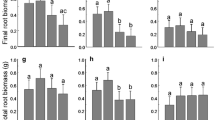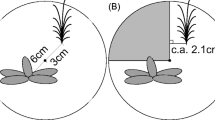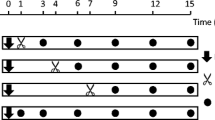Summary
Compensatory growth in response to simulated belowground herbivory was studied in the old-field clonal perennialSolidago canadensis. We grew rootpruned plants and plants with intact root systems in soil with or without fertilizer. For individual current shoots (aerial shoot with rhizome and roots) and for whole clones the following predictions were tested: a) root removal is compensated by increased root growth, b) fertilizer application leads to increased allocation to aboveground plant organs and increased leaf turnover, c) effects of fertilizer application are reduced in rootpruned plants. When most roots (90%) were removed current shoots quickly restored equilibrium between above-and belowground parts by compensatory belowground growth whereas the whole clone responded with reduced aboveground growth. This suggests that parts of a clone which are shared by actively growing shoots act as a buffer that can be used as source of material for compensatory growth in response to herbivory. Current shoots increased aboveground mass and whole clones reduced belowground mass in response to fertilizer application, both leading to increased allocation to aboverground parts. Also with fertilizer application both root-pruned and not root-pruned plants increased leaf and shoot turnover. Unfertilized plants, whether rootpruned or not, showed practically no aboveground growth and very little leaf and shoot turnover. Effects of root removal were as severe or more severe under conditions of high as under conditions of low nutrients, suggesting that negative effects of belowground herbivory are not ameliorated by abundant nutrients. Root removal may negate some effects of fertilizer application on the growth of current shoots and whole clones.
Similar content being viewed by others
References
Andersen DC (1987) Belowground herbivory in natural communities: a review emphasizing fossorial animals. Quart Rev Biol 62: 261–286
Bazzaz FA, Chiariello NR, Coley PD, Pitelka LF (1987) Allocating resources to reproduction and defense. BioScience 37: 58–67
Bloom AJ, Chapin III FS, Mooney HA (1985) Resource limitation in plants — an economic analogy. Ann Rev Ecol Syst 16: 363–392
Bradbury IK, Hofstra G (1977) Assimilate distribution patterns and carbohydrate concentration changes in organs ofSolidago canadensis during an annual developmental cycle. Can J Bot 55: 1121–1127
Brouwer R (1983) Functional equilibrium: sense or nonsense? Neth J Agric Sci 31: 335–348
Chabot BF, Hicks DJ (1982) The ecology of leaf life spans. Ann Rev Ecol Syst 13: 229–259
Chapin III FS, Bloom AJ, Field CB, Waring RH (1987) Plant responses to multiple environmental factors. BioScience 37: 49–57
Crawley MJ (1983) Herbivory: the dynamics of animal-plant interactions. Univ of California Press, Los Angeles
Detling JR, Winn DT, Procter-Gregg C, Painter EL (1980) Effects of simulated grazing by belowground herbivores on growth, CO2 exchange, and carbon allocation patterns ofBouteloua gracilis. J Appl Ecol 17: 771–778
Dixon WJ (ed) (1983) BMDP statistical software manual. Univ of California Press, Berkeley
Harper JL (1978) The demography of plants with clonal growth In: Freysen AHJ, Woldendorp JW (eds) Structure and functioning of plant populations. North-Holland publ. Amsterdam, pp 27–48
Harper JL (1989) The value of a leaf. Oecologia 80: 53–58
Hartnett DC, Bazzaz FA (1983) Physiological integration among intra-clonal ramets inSolidago canadensis L. Ecology 64: 779–788
Humphries EC (1958) Effects of removal of a part of the root system on the subsequent growth of the root and shoot. Ann Bot 22: 251–257
McNaughton SJ (1983) Compensatory plant growth as a response to herbivory. Oikos 40: 329–336
Noble JC, Bell AD, Harper JL (1979) The population biology of plants with clonal growth. I. The morphology and structural demography ofCarex arenaria. J Ecol 67: 983–1008
Pitelka LF, Ashmun JW (1985) Physiology and integration of ramets in clonal plants. In: Jackson JBC, Buss LW, Cook RE (eds) Population biology and evolution of clonal organisms. Yale University Press, New Haven, pp 399–435
Reekie EG, Bazzaz FA (1987) Reproductive effort in plants. 2. Does carbon reflect the allocation of other resources? Am Nat 129: 897–906
Schmid B (1990) Some ecological and evolutionary consequences of modular organization and clonal growth in plants. Evolutionary Trends in Plants (in press)
Schmid B, Bazzaz FA (1987) Clonal integration and population structure in plants: Effects of severing rhizome connections. Ecology 68: 2016–2022
Schmid B, Puttick GM, Burgess KH, Bazzaz FA (1988) Clonal integration and effects of simulated herbivory in old-field perennials. Oecologia 75: 465–471
Tilman D (1988) Plant strategies and the dynamics and structure of plant communities. Princeton Univ Press, Princeton
Werner PA, Bradbury IK, Gross RS (1980) The biology of Canadian weeds. 45.Solidago canadensis L. Can J Plant Sci 60: 1393–1409
Zwölfer H (1976) The goldenrod problem: possibilities for a biological weed control project in Europe. Plant Health Newsletter, EPPO Publ., ser. B 81: 9–18
Author information
Authors and Affiliations
Rights and permissions
About this article
Cite this article
Schmid, B., Miao, S.L. & Bazzaz, F.A. Effects of simulated root herbivory and fertilizer application on growth and biomass allocation in the clonal perennialSolidago canadensis . Oecologia 84, 9–15 (1990). https://doi.org/10.1007/BF00665588
Received:
Accepted:
Issue Date:
DOI: https://doi.org/10.1007/BF00665588




